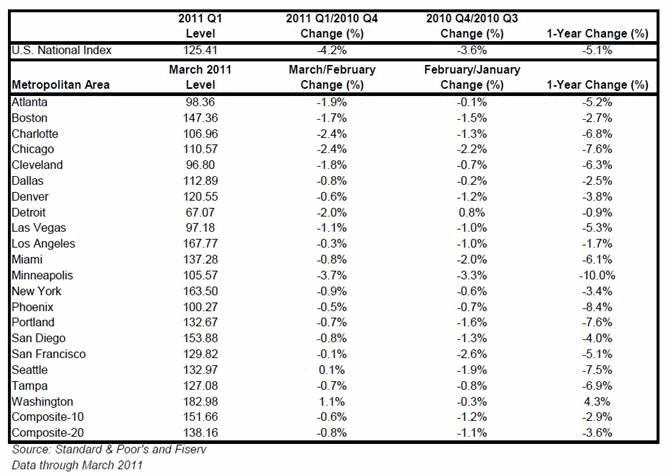The March S&P/Case Shiller Home Price Indices, released by Standard & Poor's, paint an increasingly clear picture of the "double dip" in U.S. home prices.
The indices, which are billed by S&P as the leading measure of U.S. home prices, are constructed to track the price path of typical single-family homes in a number of metropolitan statistical areas (MSAs). The study uses matched price pairs of individual houses to construct a 20-City Composite Index and a 10-City Composite Index which are updated monthly. The indices have a base value of 100 which was set in January 2000. Thus a current index value of 150 indicates there has been a 50% appreciation since that date for a typical home in the subject market.
Excerpts From The Release...
The U.S. National Home Price Index declined by 4.2% in the first quarter of 2011, after having fallen 3.6% in the fourth quarter of 2010. The National Index hit a new recession low with the first quarter's data and posted an annual decline of 5.1% versus the first quarter of 2010. Nationally, home prices are back to their mid-2002 levels.
Twelve of the 20 MSAs and the 20-City Composite also posted new index lows in March. With an index value of 138.16, the 20-City Composite fell below its earlier reported April 2009 low of 139.26. Minneapolis posted a double-digit 10.0% annual decline, the first market to be back in this territory since March 2010 when Las Vegas was down 12.0% on an annual basis.
Eleven cities and both Composites have posted at least eight consecutive months of negative month-over month returns. Of these, eight cities are down 1% or more.
"This month's report is marked by the confirmation of a double-dip in home prices across much of the nation. The National Index, the 20-City Composite and 12 MSAs all hit new lows with data reported through March 2011. The National Index fell 4.2% over the first quarter alone, and is down 5.1% compared to its year-ago level. Home prices continue on their downward spiral with no relief in sight." says David M. Blitzer, Chairman of the Index Committee at S&P Indices.
"The rebound in prices seen in 2009 and 2010 was largely due to the first-time home buyers tax credit. Excluding the results of that policy, there has been no recovery or even stabilization in home prices during or after the recent recession. Further, while last year saw signs of an economic recovery, the most recent data do not point to renewed gains."
"Since December 2010, we have found an increasing number of markets posting new lows. In March 2011, 12 cities - Atlanta, Charlotte, Chicago, Cleveland, Detroit, Las Vegas, Miami, Minneapolis, New York, Phoenix, Portland (OR) and Tampa - fell to their lowest levels as measured by the current housing cycle."
The table below summarizes the results for March 2011. The S&P/Case-Shiller Home Price Indices are revised for the 24 prior months, based on the receipt of additional source data.

In the midst of all these falling prices and record lows, Washington DC was the only city where home prices increased on both a monthly (+1.1%) and annual (+4.3%) basis. Seattle was up a modest 0.1% for the month, but still down 7.5% versus March 2010.
S&P/Case-Shiller reports data on both a seasonally adjusted and non-adjusted basis but recommends using the latter as being a more reliable indicator. We have used only the non-adjusted data in compiling this summary.







